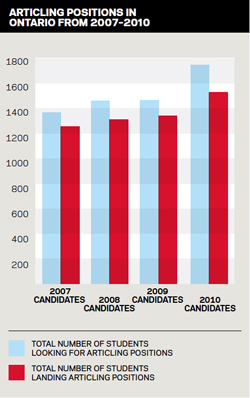
 As cries of an “articling crisis” grow louder and the Law Society of Upper Canada meets with its task force to examine the issue, good news about the state of articling in Ontario has gone under the radar: The number of students finding articling positions has actually increased year over year. Furthermore, these upward gains have been made in the midst of a major economic downturn.
As cries of an “articling crisis” grow louder and the Law Society of Upper Canada meets with its task force to examine the issue, good news about the state of articling in Ontario has gone under the radar: The number of students finding articling positions has actually increased year over year. Furthermore, these upward gains have been made in the midst of a major economic downturn.
According to a recent LSUC report, as of March 2011, 1,553 articling placements were filled for the 2010-2011 year, compared with 1,310 in 2007-2008. That’s an increase of 243 placements.
Still, the perception of a crisis persists, which can be attributed to the fact that the increase in positions cannot keep up with demand.
The past few years have seen a significant rise in the number of law students seeking articling positions in Ontario. In 2007, there were 1,391 candidates seeking spots, while in 2010 the number jumped to 1,767 — an increase of nearly 400 in a four-year period. In that same period, the percentage of unplaced candidates jumped from six to 12 percent.
A contributing factor to this growth is that some Ontario law schools have been quietly upping admissions. The University of Ottawa Law School, for example, has increased the size of its freshman class by 80 students over the past few years.
In addition, the global economic downturn has led to a decrease in the number of local law grads being recruited to work in New York City and London. As well, Ontarians trained elsewhere are returning to their home province to look for work. Even though the increase in articling positions has not kept pace with the increase in demand, Jordan Furlong, partner with legal consulting firm Edge International, looks on the bright side. “If 12 percent of students remain unplaced, that means 88 percent have found gainful employment immediately after graduation, which is extremely high,” he says. “Someone’s got to graduate in the bottom 10 percent and I think it’s reasonable for firms to look at that and say, ‘Thanks but no thanks.’”

This story is from the 2011 edition of PrecedentJD Magazine
